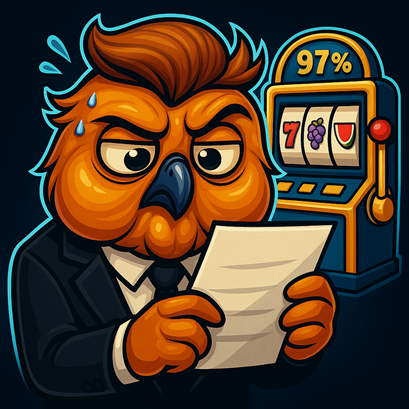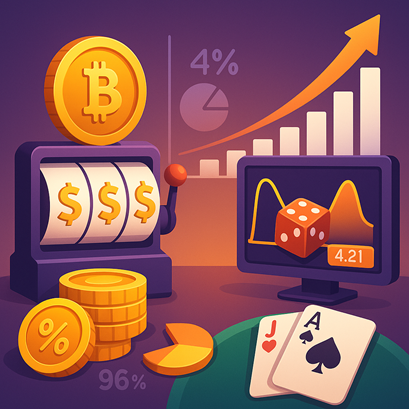How Do Crypto Casinos Make Money? An Honest Look
If you have ever played slots, watched a crash curve climb, or sweated a last leg on a parlay, you have probably wondered at some point: “How Do Crypto Casinos Make Money, and how much of this is stacked against me?”
Here at BitGamble we spend a lot of time digging into that question. Not just the marketing version, but the boring spreadsheet version too. When you understand the boring version, the fun part actually gets better, because you know what is happening under the hood.
In this guide we will come back again and again to the main question: How Do Crypto Casinos Make Money in practice, day after day, without needing to rig anything or rely on miracles. Once that is clear, you can make smarter choices about where and how you play.
The Short Answer To “How Do Crypto Casinos Make Money”

Let us start simple.
Crypto casinos make money by running games with a small mathematical edge in their favor, then spreading that edge across huge betting volume. They track every chip and coin, control their costs, and use promotions to keep you playing, so that tiny edge turns into predictable profit over time.
That is the whole story in one sentence. The rest of this article is the zoomed in view on How Do Crypto Casinos Make Money when you look at the numbers instead of just the flashing lights.
The Money Language Behind Every Crypto Casino
If you opened the internal dashboard at any serious operator, you would see a bunch of terms that show up every single day. Learning those terms gives you a clear answer when you ask yourself How Do Crypto Casinos Make Money.
Here are the big ones, in plain English.
The first is handle. Handle is just the total amount wagered. If players in a month bet 150 million $ across slots, dice, blackjack, and sports, then the handle is 150 million. You can think of it as the total flow of chips across the felt.
Next is RTP, or Return To Player. This is the long term average percentage that a game pays back to players. A slot with 96% RTP is expected, over a huge number of spins, to return about 96 percent of bets as winnings.
From RTP we get the house edge. That one is even easier. House edge is 100% minus RTP. So if RTP is 96%, the house edge is 4%.
Then we get to the really important pair of acronyms in the How Do Crypto Casinos Make Money story: GGR and NGR.
- GGR, or Gross Gaming Revenue, is handle minus player winnings. Take all the bets, subtract all the payouts, and the result is GGR.
- NGR, or Net Gaming Revenue, is what is left after the casino pays for bonuses, provider fees, taxes, and a pile of operating costs. NGR is the money that actually keeps the lights on and pays the team.
You will also hear about:
- Bonuses and comps, which means rakeback, cashback, free spins, races, and VIP perks
- Provider share, which is the cut that slot studios such as Pragmatic Play, NoLimit and live dealer providers take
- Metrics like ARPU and LTV, which measure how much revenue a typical player produces over time
You do not have to memorize the acronyms, but it helps to remember this: GGR is “money from the games”, and NGR is “money the casino can actually use”. That difference is a big part of How Do Crypto Casinos Make Money while still giving players promos and rewards.
From Tiny Edge To Real Money: A Simple Example

Now let us turn the theory into something you can picture.
Imagine a mid sized crypto casino that BitGamble might review in a real market.
- Monthly handle: 150,000,000$
- Blended RTP across all products: 96.5%
- That means a blended house edge of 3.5%
If we do the basic math:
Handle: 150,000,000$
House edge: 3.5%
GGR = 150,000,000$ × 3.5% = 5,250,000$
That 5.25 million is the raw answer to “How Do Crypto Casinos Make Money?” at this particular venue. It is not profit yet, but it is the starting point.
From that GGR, the casino now has to pay for:
- Bonuses and comps to keep players engaged
- Provider revenue share to the studios
- Payments, tech, and support
- Compliance and licensing
Only after we deduct those costs, we get NGR, which might land around 2,050,000$ in this example. That is what is available for salaries, growth, and owner profit.
The exact numbers move around, but this basic pattern is how Do Crypto Casinos Make Money in the real world.
The Product Mix That Powers The Engine
One key part of How Do Crypto Casinos Make Money is that they do not lean on a single game type. They build a mix that keeps handle high and the ride reasonably smooth.
Slots are usually the biggest engine. A typical crypto casino offers thousands of titles from studios like Pragmatic Play, NetEnt, Relax, Hacksaw, and many others. Many slots ship in several RTP versions, for example 96, 94, or 92%. A player friendly site tells you which one you are actually spinning.
Then there are in house originals. These are the crash, dice, plinko, mines, and hi lo style games you see in the “originals” or “BitGamble picks” sections. They tend to be provably fair, they play very fast, and they run on small but steady edges. High volume is what turns those edges into real GGR.
We also have live dealer and RNG tables: blackjack, roulette, baccarat, and the big game shows. The math on these games is usually tighter than on slots, but they attract loyal players and huge handle. The house takes a known edge, and over time it behaves predictably.
Finally you get sportsbooks and other markets. Here, the language changes from RTP to margin or vig. When you see two sides of a game offered at 1.90 vs 1.90 instead of 2.00 vs 2.00, that missing slice is how the book answers the question of How Do Crypto Casinos Make Money on sports.
Many modern sites also stack on GambleFi layers: points, quests, missions, season passes, and sometimes NFTs. These features make the site sticky without changing the base game math. The house edge stays the same, but the experience feels more like a progression system.
Promotions are Not Charity

Promotions deserve their own section in any honest guide to How Do Crypto Casinos Make Money.
On the surface, cashback, rakeback, reload bonuses, free spins, loot boxes, and prize pool races can feel like the casino is giving away free value. That is not what is happening.
All of those rewards are funded by the same GGR we talked about above. The casino decides how much of that budget to spend on keeping you around.
Here is how that plays out in practice:
-> Daily or weekly cashback returns a slice of your net losses, usually with very light or no wagering requirements.
-> Rakeback gives you a percentage of the house edge back as you bet, which makes grinding more comfortable.
-> Races and tournaments increase ‘handle’ by encouraging extra volume over a fixed period in exchange for a set prize pool.
-> VIP systems concentrate the juiciest rewards on the players who generate the most GGR.
From the casino side, promos are just a line item under “marketing”. They are part of the system that answers How Do Crypto Casinos Make Money while still feeling generous to regulars.
For you as a player, promos are still worth hunting, as long as you remember that the house edge is paying for them, and most importantly not make the mistake of using a bonus trap!
Where The House Edge Actually Lives
Provably fair is one of the signature phrases in crypto gambling. It is important, and here at BitGamble we care a lot about it, but it can also confuse the real story about How Do Crypto Casinos Make Money.
Provably fair means that the random numbers used in a game can be verified. It protects you from hidden tampering. What it does not do is remove the edge.
The edge sits in the payout table.
If you flip a fair virtual coin with a true 50 or 50 chance of heads, and the casino pays you 1.98x on a correct pick instead of 2.00x, the math automatically gives the house about a 1% edge.
Crash games draw multipliers from a known distribution, then shave the expected payouts just enough to keep a small edge. Mines and plinko shape their ladders in the same way.
So, provably fair answers “is this game honest”, while the payout math answers “How Do Crypto Casinos Make Money even when the randomness is transparent?”
Risk Controls: Why The Casino Does Not Go Bust
If you scroll social media you will see screenshots of monster max wins getting hit. What you do not see as often is the less glamorous risk team making sure the casino does not blow up on a bad day.
Risk controls are another piece of the How Do Crypto Casinos Make Money puzzle.
Common examples include:
- Bet caps and maximum win rules that limit the impact of a single crazy result
- Separate jackpot funding and sometimes insurance to smooth out rare huge hits
- Settings that control which RTP version of a game can be offered
- Treasury management so the casino is not overexposed to one coin’s volatility
- Hot and cold wallet design, plus withdrawal checks, to limit fraud and theft
These do not change RTP or the basic house edge. They are there so the long term math has a chance to show up in real bank accounts.
A Monthly Walkthrough, Line By Line
Let us revisit our earlier example and walk it line by line, because “spreadsheet mode” is where How Do Crypto Casinos Make Money becomes very clear.
Imagine again:
- Handle: 150,000,000$
- Blended RTP: 96.5%
- GGR: 5,250,000$
Now we subtract realistic costs.
Promotions, including cashback, rakeback, races, and reloads, might cost: 1,100,000
Provider revenue share might be: 1,350,000$
Payments, tech, streaming, security, and support might eat: 500,000$
Compliance, licensing, audits, and responsible gambling tools might cost: 250,000$
After all that, NGR is about: 2,050,000$
That number might shrink further when you factor in acquisition costs for affiliates and creators. Whatever is left is the true profit. That final slice is the part of How Do Crypto Casinos Make Money that never shows up on the promo page, but it drives every decision.
What This Means For Your Bankroll
So what does all of this actually change for you, the person who searched “How Do Crypto Casinos Make Money” and ended up here on BitGamble?
A few very practical things.
First, you understand now that the edge is a long term concept. You can absolutely win in the short term. People hit jackpots every week. But over thousands of spins or bets, that three or four percent edge wants to show up.
That means:
- Try to pick games with RTP of 96% or higher when you have the choice.
- Choose volatility that matches your bankroll and stress level. High volatility can be thrilling, but it needs smaller bet sizes and more patience.
- Read the game info panels. Look for RTP, volatility, and any notes about bonus buys changing the math.
- Treat your gambling budget like what it really is: paid entertainment. Set a limit on time and money before you start, and respect both.
- When comparing casinos, check whether they disclose RTP clearly and whether they pick the higher configurations when possible.
Understanding How Do Crypto Casinos Make Money will not make you magically beat the house, but it will help you avoid bad deals and pick sites that treat their edge honestly.
Quick FAQ About How Do Crypto Casinos Make Money
Do cashback and rakeback erase the house edge?
No. They are funded from GGR. Think of them as a discount on your entertainment, not a cheat code.
If a game is provably fair, does that mean the casino has no advantage?
No again. Provably fair handles the randomness. The house edge is baked into the payouts, which is a core part of How Do Crypto Casinos Make Money on provably fair titles.
Why do two casinos list different RTP for the same slot?
Because studios often ship multiple configurations. One operator might run the 96% version, another might pick 94 or lower to increase GGR. Transparent casinos tell you which one you are getting.
Is sports betting a separate story from casino games?
The mechanics differ a bit, but the logic is the same. In sports, the book earns a margin or vig instead of using RTP, yet it is still the same idea: a small edge multiplied by big volume, which fits perfectly into the bigger picture of How Do Crypto Casinos Make Money.





